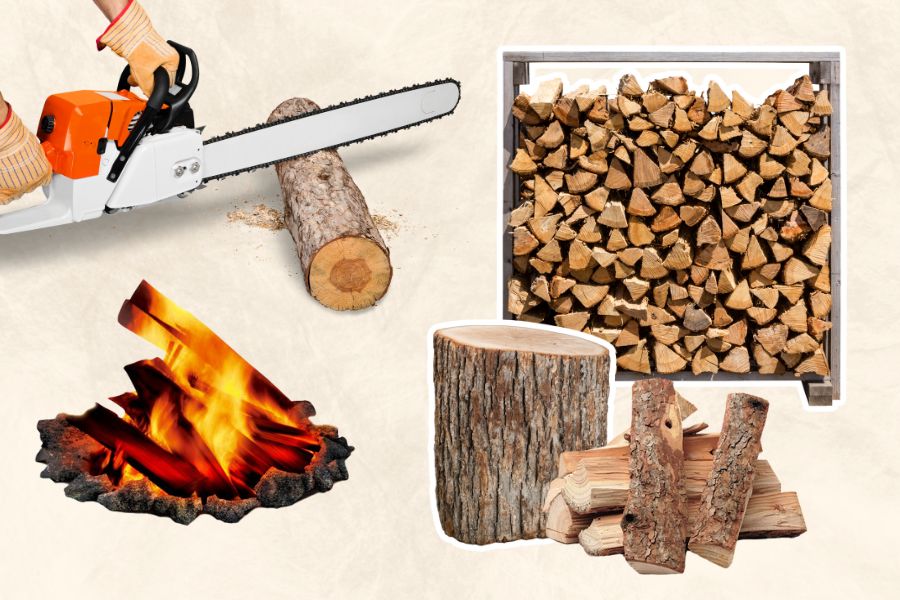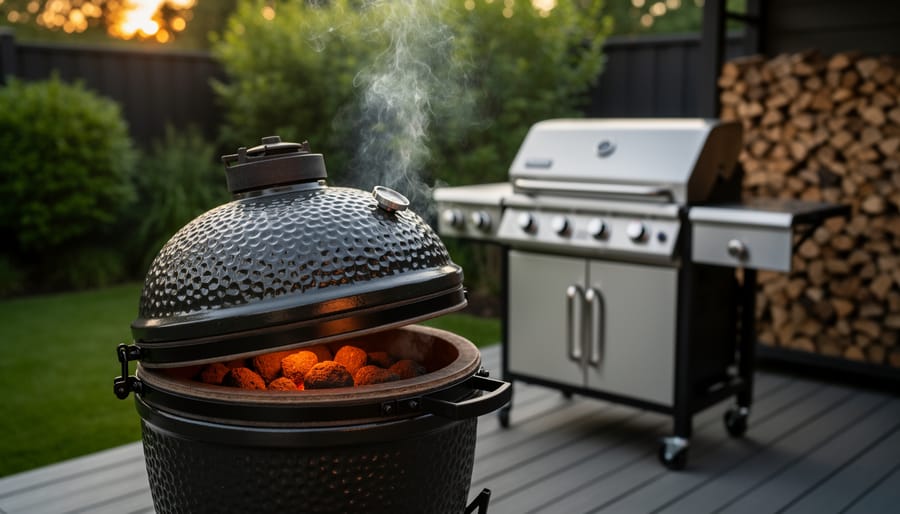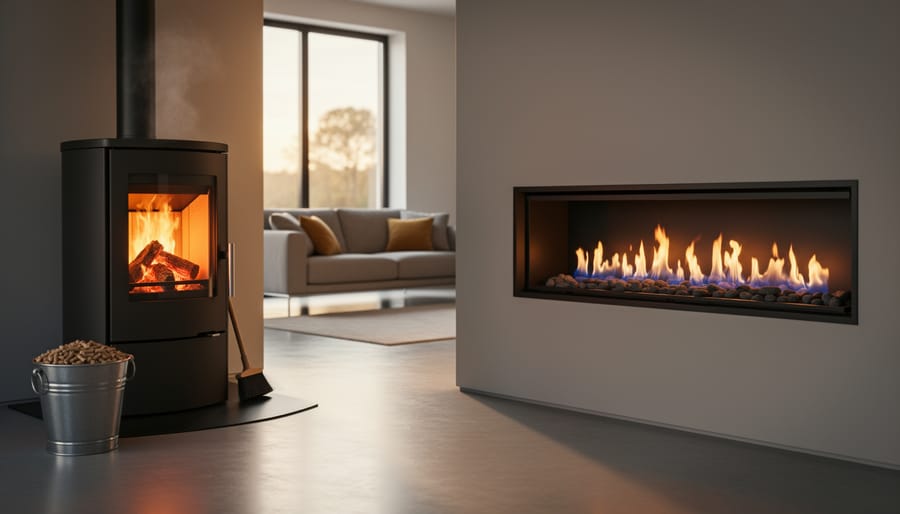Heat is a necessity for survival, particularly during the winter months. But it can be incredibly expensive to rely on electric heaters or gas heat that cost a fortune. Fortunately, a third option exists that is more economically and environmentally friendly. And as a bonus, it is more rewarding and effective than the alternatives. That option is burning firewood for heat.
Burning firewood can be very advantageous, whether in a wood stove, fireplace, fireplace, wood-burning fireplace insert or even an outdoor fireplace. Here, we’ll review the best firewood to burn and everything you’ve ever wanted to know about firewood!
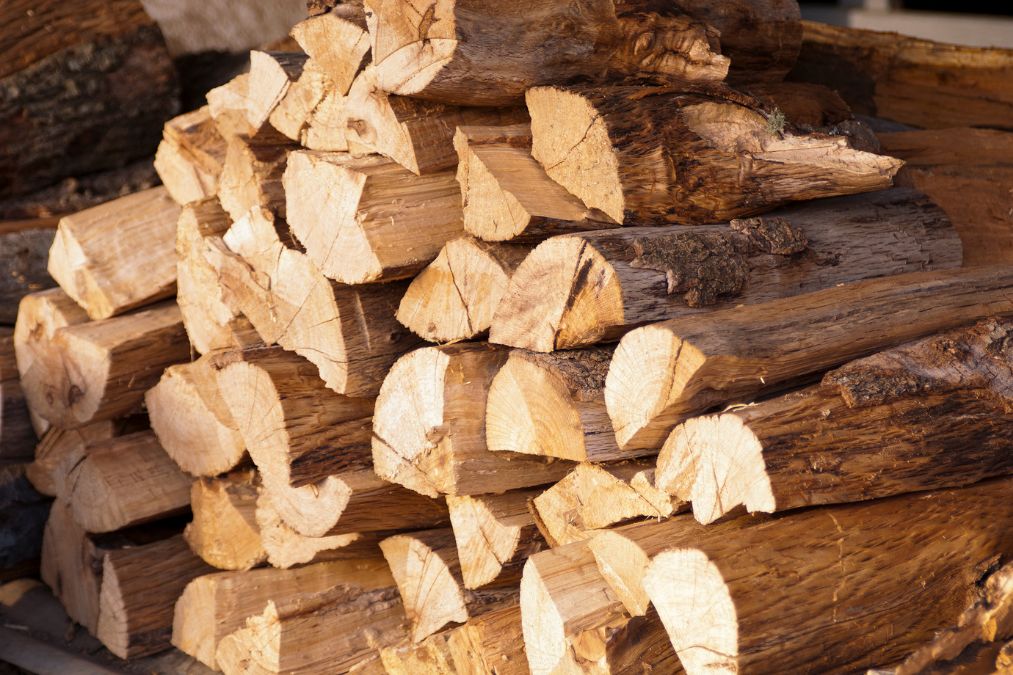
The Firewood Landscape
Venturing into the vast firewood-burning world can be intimidating to newcomers. The concept of burning wood for heat is somewhat simple. But there are a number of specifics to take into account. You want to ensure you’re making the process as effective as possible.
One of the primary reasons people are intimidated is because there are so many different kinds of firewood to choose from. When making your choice of firewood to burn, you’ll see some recognizable names such as oak, pine, and maple for the source of the wood. But you’ll also see specifications of the wood, like hardwood, softwood, greenwood, and seasoned firewood. With all these different choices and their combinations, it is no wonder that people look for help when starting out burning wood for heat.
Fortunately, once you learn the different types of wood and how they “stack up against each other”, the decision becomes much easier! In this article, we’ll do just that while helping you decide whether you should buy or cut your wood, how to store and dry it, and common measurements of wood to keep you informed when buying.
Hardwood vs Softwood
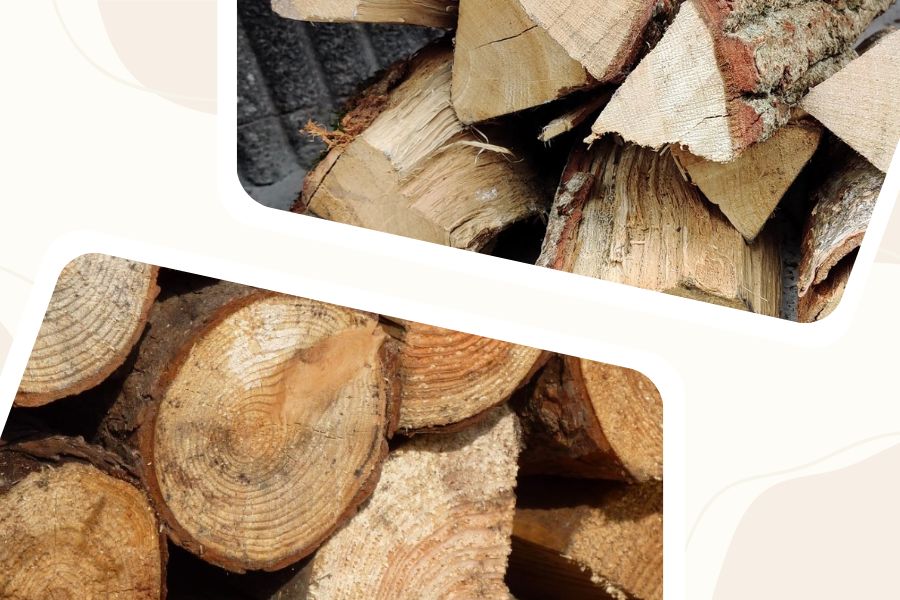
The first of the primary distinctions of wood is Hardwood. Hardwood, as you can likely guess, generally refers to wood from trees that produce hard, thick pieces of wood. The trees that contain this density of wood include maple, elm, beech, oak, and many more due to it being the more popular classification of wood.
If you cannot identify the breed of the tree, you can use the leaves to determine its wood type. Hardwood trees are broadleaf, meaning that they have leaves that are flatter and broader than average. This allows them to better absorb light during warm seasons but causes their leaves to die in the winter.
Why Choose Hardwood for Burning
First, because the hardwood is so thick, it creates a hotter, longer-lasting fire than softwood without a lot of smoke or sparks. The lack of smoke is great for the environment, and those huddled around it who are breathing in the fumes, but the lack of sparks is also great for the overall stability of the fire. With softwood, you will get more sparks and smoke because it burns more aggressively and quickly.
As an added bonus, burning hardwood as firewood will create hot coals that radiate heat for a long time. This is especially useful for long overnight cooks as with a softwood fuel source, your fire will likely be out by morning because there are no hot coals to keep the fire burning or to restart it when it goes out from burning too quickly. For overnight burns, slow and steady wins the race!
Another slight downside to softwood is the extra time invested in order to keep the fire burning. Softwood burns much more quickly than hardwood as it is much lighter and thinner. Because of this, you will need about twice as much softwood to match the density of the hardwood. As a result, you need to do twice as much cutting, splitting, and stacking, which nobody wants to do.
All About Softwood Firewood
What Is Softwood?
The other primary classification of wood is softwood. No surprises here; softwood refers to wood that comes from trees that produce softer, thinner pieces of wood. Some popular softwood trees are fir, red pine, and cedar.
These trees can also be identified by their leaves, and usually have “needle” and other thin leaves that can contain a pine scent similar to a Christmas tree! They also do not lose their leaves during the winter, which is why you will see them outside during the winter to be used for a Christmas decoration or burning.
Why Choose Softwood for Burning
With all the great benefits of hardwood listed above, it begs the question: why would someone burn softwood if hardwood is so much better?
For starters, when buying the same amount and quality of softwood and hardwood, you should expect to pay more for the hardwood. Softwood is also much easier to light but burns much more quickly than hardwood. As a result, softwood is great for situations like a campfire where you may be battling outside forces such as wind resistance from nature, so you’ll need your fire to be as easy as possible to start. It is also better for when you want to create a short-term fire and be able to easily extinguish it without causing a fire hazard.
On top of that, softwood is also much easier to prepare than hardwood, taking much less time to season than hardwood. If you are cutting, preparing, stacking, and burning your own wood, this means more time and effort for you. Without the seasoning and preparation of the wood, you’re going to have “green wood”, which is a poor burning experience and should be avoided.
Aside from their appearances and density differences, soft and hard woods also differ in the way they burn. When asking most firewood burners about hardwood vs softwood, they will tell you that hardwood is superior, but this isn’t always the case.
It comes down to the quality of the wood more than which classification it falls under. This means that a high-quality softwood will trump a low-quality hardwood. However, hardwood is typically considered the better of the two for burning, disregarding the preparation and quality of the wood.
Comparing the BTUs (Energy Output) of Softwood and Hardwood
Amongst other things, one of the main benefits of hardwood is that when purchased by the cord, you will see a result of more BTUs produced than a cord of softwood that is similar. A BTU (or British Thermal Unit) is a unit of measurement for heat. It’s basically defined as how much heat you need to raise the temperature of one pound of water by one degree Fahrenheit.
To break it down even more simply, the more BTUs produced per cord of wood equals more energy produced when the wood is burned. In order for the wood to ignite, the temperature needs to reach between 300-400 degrees Celsius, depending on its density (hardwood has a higher density and therefore requires a lower temperature to ignite).
More energy is definitely a great asset. And while it does produce more energy-burning hardwood, it also is much more of a hassle. Firewood with a higher BTU per cord tends to be harder to split and light. The burning results may be “better,” but many people choose to go with a higher middle-end BTU firewood. This is so they get efficient firewood and reduce the possible hassle. It’s the best of both worlds.
Some great examples of higher BTU firewoods are oak, hickory, maple, and ironwood. But if you want to go with a middle selection, you’ll want to look at birch, ash, elm, and fir.
Although higher BTU hardwoods are great for long-term, roaring fires, nothing beats the ease of lower BTU softwoods for shorter and softer flames. Some great lower BTU alternatives are pine, spruce, cedar, and hemlock, which will be more than enough to keep you warm while you tell campfire stories. Just be ready to light the fire again in the morning!
Now that you’ve heard the cases for both sides, you probably want to know the strongest firewood available so that you can consider it for your fireplace this winter. The title of strongest firewood (in terms of BTU capabilities) is the live oak. Live oak boasts an impressive 36.6 million BTUs per cord (and a price to match!). If quality and efficiency are your goal, look no further than live oak as your hardwood option and enjoy your heat source all night.
To make your options for choosing a wood to burn easier to understand, here is a chart you can reference to understand the differences between some common woods and why you might choose them:

As you can see, the softer woods are lighter and produce less BTU output than the hardwood. This table does not factor in price, which would be a major factor as hardwood usually costs more than softwood.
Green Wood vs Seasoned Wood
You’ve heard everything there is to say about the types of wood you can choose from, but another important aspect to consider is the quality of the wood. This brings us to something you might run into called green wood.
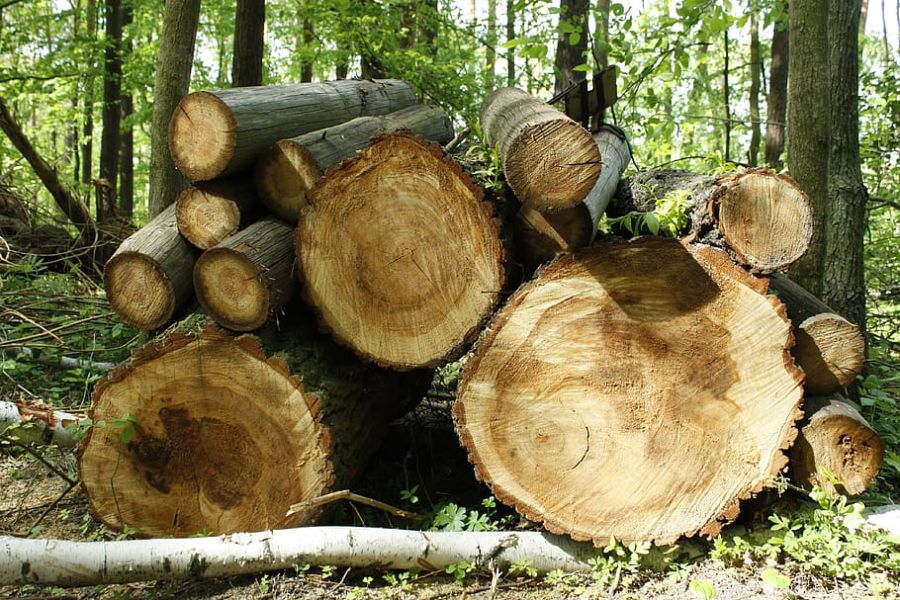
Greenwood is something you should avoid at all costs, as it isn’t a type of wood like softwood or hardwood. Firewood can be classified as green wood or seasoned, and you almost ALWAYS want dried seasoned wood.
An important aspect of how well wood burns is the moisture of the wood. When burning wet wood, you are likely to hear hissing, popping, and bubbling because the liquid in the wood is expanding from being superheated.
Dangers of Burning Wet Wood
Wet wood also gives out about 66% more harmful particles for every 10% moisture content in the wood. A smoke-producing fire is typically full of these toxins. As a result, it makes burning very wet wood dangerous to your health in enclosed areas. Because trees are living things, they contain moisture that has to be removed and dry out naturally, often referred to as “drying” or ”seasoning”.
When you first cut a tree down, before it can be used for firewood, in most cases, it needs to be seasoned for a minimum of 6-9 months so it is able to fully dry out. Once it is dried, the moisture pockets that cause the noises are gone, and it is able to burn more cleanly and efficiently. This increased the BTU output as well as overall eco-friendliness.
The only negative of seasoning the wood is the time and money costs to allow it to dry for extended periods. This is why purchasing seasoned wood will cost more. However, many believe quality is more important than quantity in wood burning, so it is worth the extra cost!
Tips for Cutting Your Own Firewood
Choosing to cut your own firewood to heat your home can be one of the most rewarding things you can do.
Not only do you get the reward of an abundance of saved money from not having to buy your firewood, but you also get the pure satisfaction of knowing that you are the contributing factor to your home being heated.
The Best Season to Cut Firewood
The most important thing to consider is when you want to begin cutting your firewood. Each season has many advantages and disadvantages, but the season I recommend is right in the springtime. You will have the advantage of the cooler air to help make the chopping and cutting of the wood less uncomfortable, and it also leaves time for seasoning the logs before you can use them as effective firewood!
The 7-9 months wait after you cut your logs in the spring should be enough time for most types of wood to dry out and be ready to heat your home when the cold arrives come winter time. Otherwise, you will experience popping, lower heat output, and more harmful particles in the smoke.
The Best Trees for Firewood
Next, you’ll want to know what kinds of trees are good to cut for firewood to heat your home and which are not good choices!
For heating your home regularly, you’ll want to choose firewood with a middle to high BTU amount. You’ll also want a hardwood, as choosing a lower quality softwood with a lower BTU amount would result in wood burning much quicker and require restarting overnight.
Some softwoods also release toxins into the air that can damage your chimney and start fires, so they are mainly best for campfires, bonfires, and outside fires in general, where the fumes cannot cause damage to the lungs or chimney.
The very best type of tree you can find is oak. Oak is going to be generally the most valuable and also the most efficient wood to be used as firewood. They are hardwoods with a high BTU. This means they are able to pump out more heat for longer periods than softer woods.
If oak isn’t an option for you, some great other choices to watch are maple, birch, and hickory. Everyone knows names like oak, but there are other great ones such as Osage Orange, Ironwood, Dogwood, or apple trees. Many can provide a similar experience without the higher expected cost!
Equipment Needed for Cutting Your Own Firewood
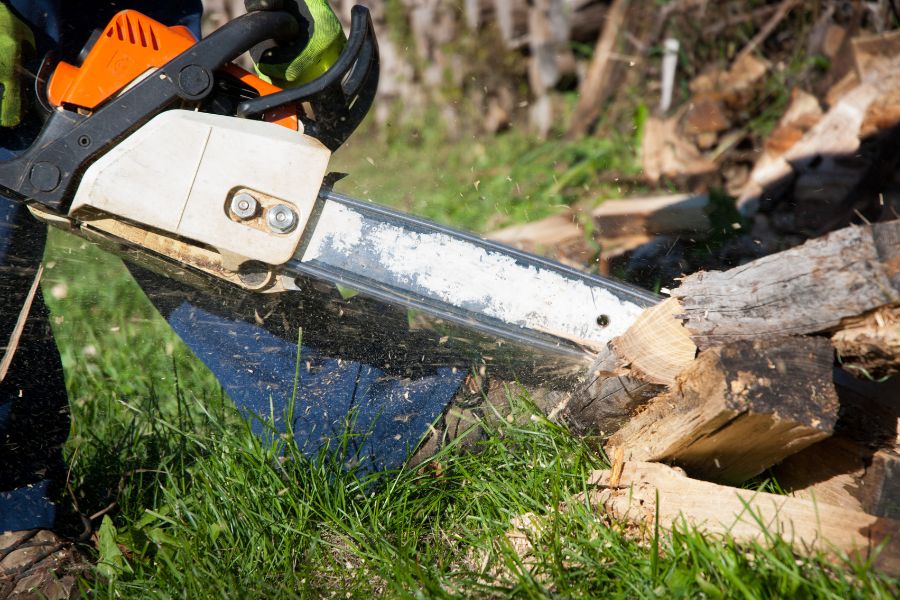
Now that we know what kind of trees we should look for, and possibly even picked out one or two already, it’s time to think about the equipment we’ll need in order to complete a job like this.
Safety Gear for Cutting Firewood
The most important thing to consider is your safety, as enjoying the fruits of your labor with all your fingers and toes is easier! It’s essential for everyone cutting their own firewood to equip them at least with a pair of work gloves, safety goggles, and steel-toe boots to avoid injury when using tools.
Another great thing to have is a pair of protective chaps. In the case that the chainsaw comes into contact with you at any point, it will stop the blade instantly. This helps prevent potentially catastrophic damage. Don’t spend the money you’re saving cutting your own firewood on hospital bills!
Tools Needed for Cutting Your Own Firewood
A rope to help guide the tree in which direction to fall could also come in handy and save a life. Finally, the most crucial of all the safety equipment is having a friend with you. Accidents happen, and anything can go wrong, so it’s great to have somebody with you to prevent accidents or respond in an emergency.
The best thing to use is a chainsaw when it comes to specific tools to cut down the tree and split the wood. There are a few different chainsaws, but for cutting enough firewood to heat your home for winter, you definitely want to go with a gas chainsaw.
Battery and electric-powered chainsaws are great for small home projects, but you’ll need the power and reliability that a gasoline-powered chainsaw brings when supplying enough wood for your entire home. Setting everything up and preparing can be a tedious and long task, but cutting the tree down is fairly simple and straightforward.
Step by Step for Cutting Your Own Firewood
- First, you must identify that the tree you are cutting down will work for firewood. Be sure to take notice of the leaves, as they are a good indicator of whether the tree is soft or hardwood. This can give you a better idea of what to expect when cutting.
- Next, you should see if the tree is leaning or if it naturally wants to fall in a certain direction. Cutting the tree down can be even easier with gravity on our side, and we definitely don’t want to battle gravity when it’s time for the tree to fall, as gravity wins that battle 10/10 times!
- Next, I would suggest a friend ties a rope around the tree to help maintain control of it to help guide the tree in the desired direction. From there, it is fairly straightforward, and all you need to do is cut through the tree and allow your friend to guide it where you would like it to fall.
- Once you cut down the tree, we need a way to transport it. One of the best ways to transport firewood is simply with a firewood cart. It’s a cart with wheels that easily allows you to transport high amounts of wood by leveraging one of society’s greatest creations, the wheel.
- Now that we have our logs, our job is to cut the log into smaller pieces with the chainsaw so that you are then able to split that into firewood that will go in your fireplace or furnace. A great size to cut into is approximately 16 inches long. This allows it to fit in most fireplaces and woodstoves with no issues.
- The measuring is as straightforward as you imagine, but here’s a tip that might save you some trouble: you should only see three-quarters of the way through the log, flip it over, and see through the rest. The reason for this is you’ll end up sawing into dirt or rocks, which will very quickly and easily dull the chain of your chainsaw, making it harder to cut future logs.
Since the chainsaw is already the best way to cut the tree itself down, many people also use the chainsaw to split wood instead of the axe like some others. There’s no need to do all the work yourself. A chainsaw will power through the wood itself, so you don’t have to!
Setting up the log to split with a chainsaw is the same as with an axe. You want to stand the piece of wood up straight and then simply power down the middle with the chainsaw. It’s important to take it slow and allow the chainsaw to do the heavy work, not you.
It would be wise to wear the same safety equipment as you did before, especially protective chaps. This is because you can sometimes hold the chainsaw close to your body. If it catches the wood the wrong way, the chainsaw or wood shards can come flying at you.
That’s it! Now that you are finished with all of the cutting and splitting required, you should be ready to get into seasoning your firewood for the winter to ensure all your hard work is worth it.
Firewood Seasoning
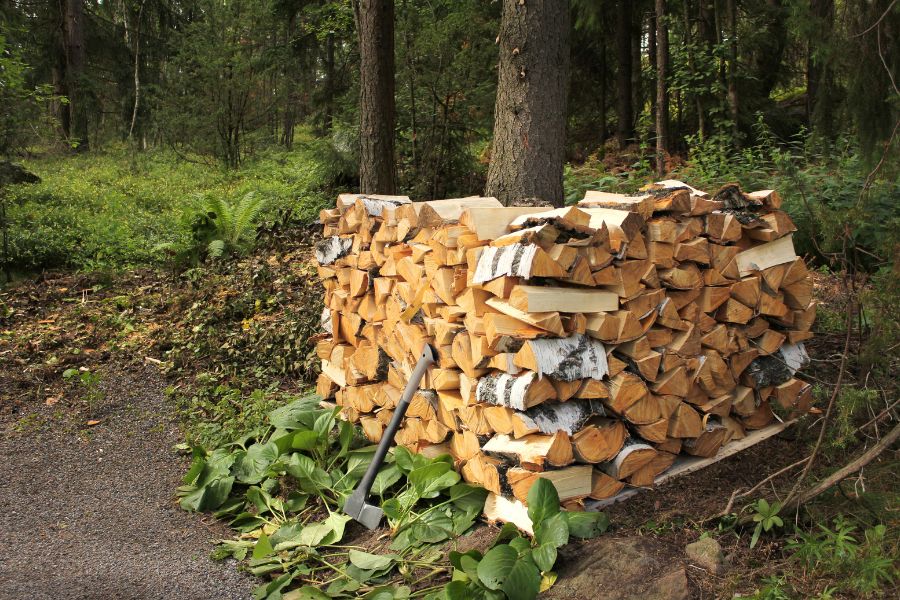
Seasoning or drying out your firewood can be a very simple task for seasoned veterans who know the intricacies of the practice. But can be very confusing for some and, if done incorrectly or inefficiently, could leave you needing to abandon your current stock and buy your firewood this winter!
How Long Does It Take To Season Your Firewood
Before you even think about drying your wood, you need to find out about the type of wood you’re drying. Many types of wood have different qualities. Some woods, such as black locust or cherry, have low moisture content. Therefore, they will gain minimal benefit from air drying. However, a wood like elm or cottonwood, which have much higher moisture content and benefit more from longer drying times, will need to be air-dried for an extended period of time to be the best quality wood possible.
Another aspect that is important to consider is how long that type of wood takes to dry out. Some softwoods require as low as only 6 months to fully dry out. But if you’re waiting for oak it could be up to two years due to its density!
This process can take so long because it’s not just about the outside bark of the tree being dry, but the moisture levels within the wood are what matter. The entirety of the firewood needs to be fully dry. Otherwise, the wood will burn unevenly, inefficiently, or even not at all. The moisture in the wood will be heated by the flame (if you can get it to light!). This causes it to crack the wood, make popping and crackling noises, and create a more harmful smoke than drier wood.
Where to Season Your Firewood
Since we now know what type of wood we’re dealing with and all about that type of wood, we need to get into actually beginning the process of seasoning it!
First off, we need to find a suitable location for our firewood. It’s essential that we find a place that is outside. If termites are possibly present, you don’t want them near your house. It should also be as dry of a climate as possible. Additional moisture in the air makes it harder for wood to dry once cut!
Another important thing to do is to leave space between the stacks of wood and any walls. Each side of the stack needs free air circulation to ensure that the wood dries as quickly as possible, as without it, the wood will simply soak.
How to Prepare Your Firewood for Seasoning
Now that we have our location, we should gather and stack the wood pieces on top of each other. The actual dimensions of your wood stack aren’t important unless you’re measuring your haul or selling it. So just ensure that you don’t stack the wood too high that it will fall.
Under each stack, you should have two saplings cut to go under the stack, acting as a base. This prevents the firewood from touching the ground and possibly becoming wet or contaminated by something on the ground.
The best time to take advantage of seasoning wood is during the summer. The heat from the sun is a great asset in drying out the firewood more quickly. In other seasons, evaporation takes longer and is more likely to rain or snow. You’ll be able to fully take advantage of drying wood in the summer if you choose to cut your wood in a time other than spring. If you are seasoning a hardwood like oak, that will take 1-2 years.
Since we need to keep the wood stacks outside, it is crucial that you cover the top of each stack. This helps protect it from snow and rain. However, you need to uncover the ends of the stack to allow air to circulate through. As a result, the moisture can easily escape.
There are many different ways to stack firewood for drying. You’ll need to assess your available space to determine the best way.
Wood can all look extremely similar at times, and the same definitely applies to wet and dry wood. A wood moisture meter is the best way to tell if your firewood has completed the seasoning process. This device that you simply stick into the wood easily detects the amount of moisture remaining! This device makes it incredibly simple to tell when your firewood is ready for use.
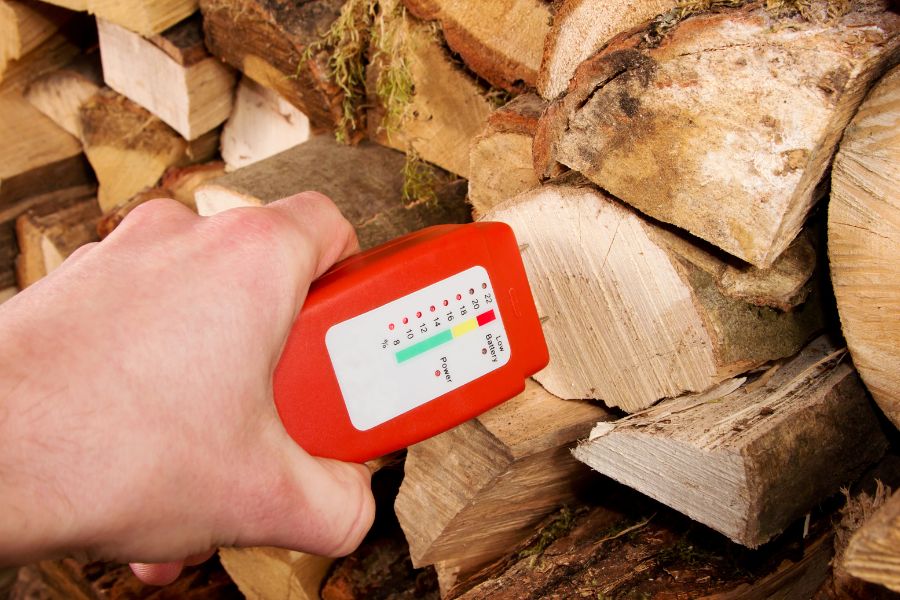
Firewood Storage
Selecting a location and way to store your firewood may seem like something that shouldn’t and doesn’t require much thought. However, overlooking the significance of storing your wood is an easy way to spoil your whole haul!
Generally, storing and stacking most of your firewood outside in a dry location is best. When you are seasoning or drying out your wood, it prevents moisture accumulation and dries it out.
To summarize, the best way is to simply stack the wood outside with two saplings under each. This aims to prevent the stack from touching the ground. It’s also important to ensure the stack is not touching any walls. Additionally, a cover on top serves as protection from any rain or snow.
Unfortunately, there are some downsides to choosing to store your firewood outside. Once you begin to split your firewood, it will no longer be able to stack in the same way without any assistance. Along with this, bringing in new firewood from your supply outside will be much too cold to put in your fireplace because it will cool the fire down too much. You need to combat this and ensure you always have a steady supply of readily available wood. The best way is to maintain a two to three day supply indoors at all times. This gives it time to warm up.
Finding a storage method for indoors is incredibly easy. Numerous stylish and amazing storage containers and racks are built specifically to hold firewood. There are thousands of different designs, shapes, and styles of storage for firewood fit to serve basically anyone’s needs!
Bark Up or Bark Down – The Age Old Debate!
Where and how to store your firewood are important questions to ask yourself. But it’s also important to consider how to place your firewood within the container or rack. A common question that wood burners ask is whether you should store your split firewood bark up or down. This sounds very simple and silly. Many people may even carelessly just throw their firewood in without noticing what they are doing.
Consider the surrounding environment when deciding whether to place your firewood bark down or up. In an inside environment it really does not matter much what you decide. This is because the climate is relatively controlled.
However, many believe placing your firewood bark in an outdoor environment is essential. The outside environment can cause extra moisture to accumulate under the bark. And this could possibly cause fungus to grow on the wood. Placing the firewood with the bark facing up can help to act as a shield from the bacteria. It can also prevent possible moisture that can deter the progress of drying.
Cords, Half Cords, and Ricks of Firewood
Whether you are buying or selling firewood, it is very important that you are well-versed in the types of measurements of wood.
Cord of Wood
The most common measurement of wood you will come across is most likely a cord of wood. We don’t measure a cord of wood by how heavy the wood is. It isn’t even how many pieces of wood are stacked together. Instead, a cord of wood is measured by the stacked wood’s length, width, and height.
A complete cord of wood should measure eight feet long, four feet wide, and four feet high. While the wood’s weight does not define a cord of wood, on average, a cord of wood will weigh over two tons. That will buy you a lot of time by the fire!
Plan accordingly if you’re not getting the cord delivered. Wood has sheer size and weight. As a result, an average-sized pick-up truck will need to make two trips to transport a full cord. From there, you’ll want to transport your wood using a wheelbarrow or garden dump cart to its final storage location.
Half Cord of Wood
A half cord is exactly half of a full cord of wood. This measures four feet long, four feet wide, and four feet high.
Rick of Wood
Another measurement you will come across is a rick (or face cord) of wood. A rick of wood is different from a cord or half cord of wood. This is because instead of measuring in three dimensions, it only measures in two.
A rick of wood is eight feet long and four feet high. This doesn’t mean it doesn’t have a width. It just doesn’t have a defined one, so you will see large variations in pricing and quantities. The width can range from as low as 16 inches to as high as 24 inches.
Because of this, it can be both tricky and risky to buy a rick of wood. You may be getting one-third of a full cord, or you may be getting half a cord of wood! Therefore, we recommend you stick to just the 2 standard measurements of a full cord or half cord.
Measuring your Firewood
Now that you know the common measurements of wood, you may want to measure your own wood supply. You may even wonder how much wood you’ll be getting from each tree you cut down.
How Much Firewood in a Tree
As you may have guessed, trees come in many shapes and sizes. Bigger trees definitely tend to give more wood than smaller trees. But with some simple measuring you can easily and rather accurately predict how much wood you will get from a specific and/or group of trees. The only tool you need for this project is a cloth measuring tape.
How to Measure a Tree for Firewood
- Measure four and a half feet up the tree trunk. This will be the point where we’ll measure the tree’s circumference.
- Wrap the measuring tape around the tree to measure the complete circumference of the tree.
- Divide the circumference by 3.14, the tree’s exact diameter.
- Use the chart below to determine how much wood the tree will yield.
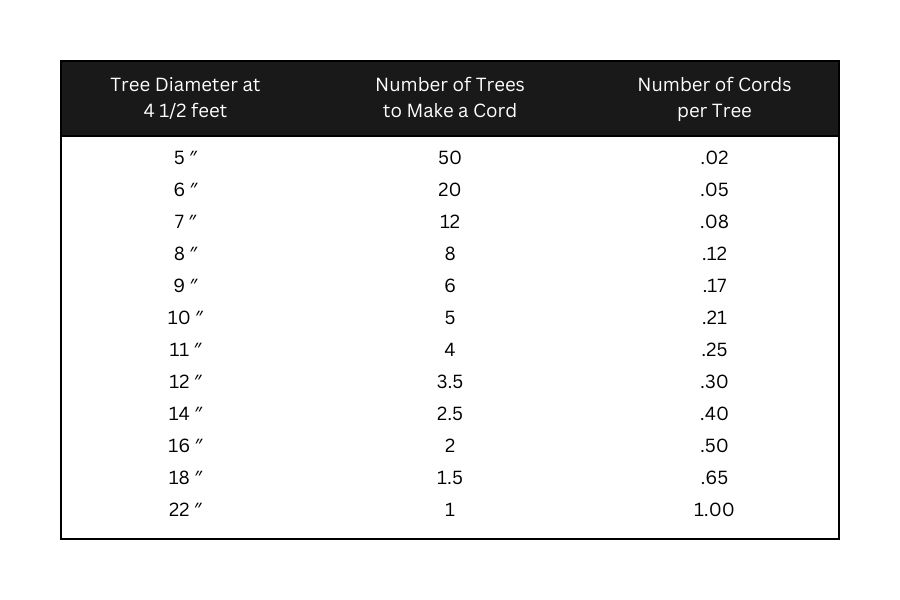
How Long Will My Firewood Last
Every wood burner should know exactly how long their wood is going to last. And the answer really depends on a few variables, such as the location and size of your home. But it also boils down to how many appliances you need to fuel. Many people need wood stoves to heat floors in entire homes all winter. This can easily use up to 9 or 10 cords in a winter or even more!
However, some people who have smaller homes will use them less often. They may also have fewer appliances and only need two or three cords every winter. On average, about five cords of wood should get most people through Winter. And if not, it will definitely last long enough to allow you time to purchase more if needed. Just be sure you don’t run out entirely! If you purchase one cord at a time, you can expect it to last anywhere from two weeks to a month on average.

